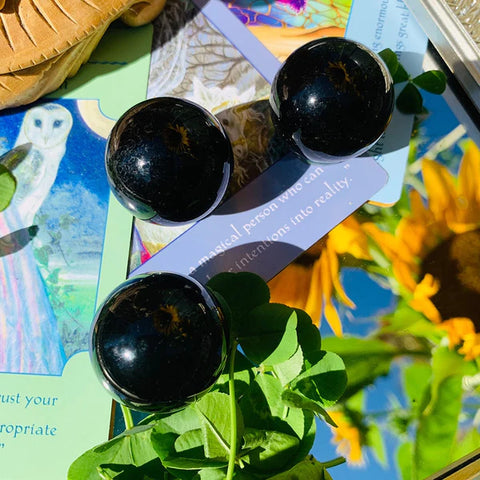10 Things You Didn’t Know About Black Obsidian
More crystal meanings on our blog at www.crystalgemstones.net
Obsidian is a stone formed by the rapid cooling and hardening of lava and in its black form, has been very sought after since antiquity. Its uses range from practical to metaphysical, weaponry and divination alike. Black obsidian is best known for its ability to ground, protect, transform, and impart strength to the wearer. Its manifestation properties lend energies of strength, creativity, and insight which are especially vital in any spiritual practices. But the question remains, where did it come from and what was it used for initially? Here are 10 things you didn’t know about black obsidian.
1. Black obsidian, an Aztec currency
The use of black obsidian dates as far back as 100 years BC. Despite its abundance in the area, obsidian was still considered highly valuable and precious to the Aztec society and Mayan merchants would use it as a trading tool, much like we would trade gold in later times.
2. Black obsidian, practical uses
Before the invention of modern day technology, ancient civilizations would utilize more innovative and creative methods for creating the tools that made their lives easier. Black obsidian is among many crystals that were carved and shaped into the form of weaponry such as spears, arrowheads, knives, and other essential tools of survival.
3. Black obsidian in ancient rituals
Trepanation is a medieval surgical procedure by which a hole is carved into the human skull for medical purposes. However, up until the early 19th century, certain tribes in Polynesia and Africa would practice trepanation to allow for the entry or release of spirits into and out from the human body. Due to its surgical precision (and perhaps also because of its protective properties), black obsidian was considered the safest tool for these practices. Many Mesoamerican societies would also use obsidian blades for bloodletting and sacrificial offerings.
4. Black obsidian, piercing the veil of illusion
Because of its color and sharpness, obsidian is believed to hold the ability to pierce the veil of illusion and reveal hidden truths. Many ancient civilizations would practice this form of divination in their own unique ways, but the concept remains the same. As it was linked to the god of witchcraft and divination, Mayan prophets would use polished obsidian as scrying mirrors while others would spill water upon the surface and observe the shapes left behind.
5 Black obsidian, a gift from an angel
The idea of divination survived through the ages as Dr John Dee (1527-1608) planted occult roots in the modern world. As part of the court of the queen of England, he would introduce his system of magical beliefs, including his claim of being able to communicate with angels. He owned a “magic mirror” which he claimed was given to him by the Angel Uriel, and which he used to tell the future and uncover various plots against the crown, ultimately making him famous. This mirror was, in fact, an Aztec scrying mirror made of obsidian that was brought back after the Conquista.
6. Black obsidian in Christianity
After the conquest of Mesoamerica by the Spanish, the symbolic representations of black obsidian were realigned. It was then used to decorate early Christian atrial crosses, a merging of beliefs between the natives from whom it was taken and those of the people who took it. It can be supposed that it was chosen for its protective properties as well its correlation to the divine.
7. Black obsidian, surgical precision in modern day
As you can imagine, being volcanic glass, obsidian can provide very sharp edges when broken. Because it can produce such thin blades, it is still used today in many surgical practices for its precision and sharpness, carrying its historical uses into modern day medicinal practices. Today, obsidian blades are incorporated specifically into cardiac surgeries and eye surgeries.
8. Black obsidian and Aztec deities
In relation to its divinatory uses, black obsidian was held sacred among the Aztecs for many reasons, the main one being its relationship to the god of The Great Bear constellation, Tezcatlipoca meaning smoking “obsidian” mirror. This versatile black crystal was also associated with the warrior goddess, Itzpapalotl or obsidian butterfly and the god of cold and frost, Itztlacoliuhqui or curved obsidian blade.
9. Black obsidian in mythology
This famous protective crystal has roots deep within many beliefs and practices throughout history. According to Aztec myth, the virgin mother of gods (coatlicue) gave birth to the moon (coyolxanuhqui) and the stars after she became magically impregnated by an obsidian blade. In some versions of the creation story, the heart of man would have been created by the gods with obsidian.
10. Black obsidian and the 4 mountains of Navajo
Although most of the lore and history surrounding black obsidian come from the ancient Mayans, its metaphysical relationship to humankind also sits in other cultures and beliefs. In Navajo culture, their ancestral homeland sits at the center of four sacred mountains, each represented by a different stone and cardinal direction. In Emergence, their creation story, First Man took four stones, each of a different color: black (obsidian), white (white shell), blue (turquoise), and yellow (abalone). He placed each at one of the four directions, blew on them four times and they grew into a Hogan (the world).




